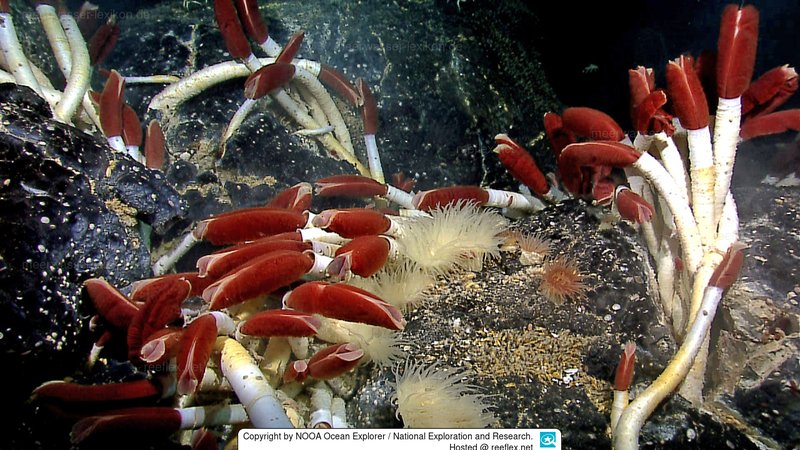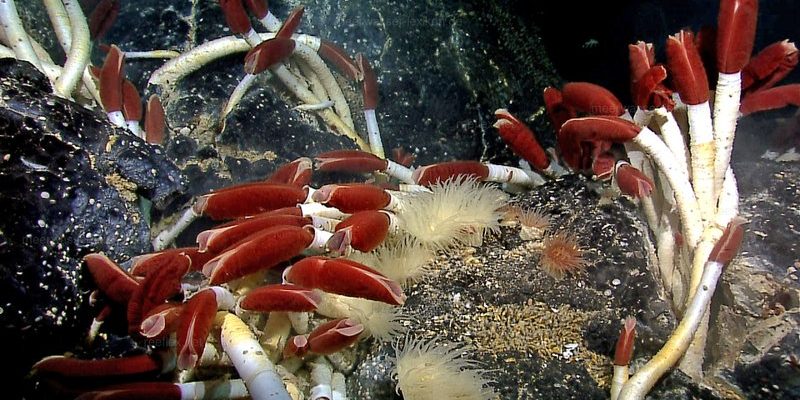
Imagine living in a place where sunlight never reaches, yet you thrive in an environment that’s over 750 degrees Fahrenheit and filled with minerals from the Earth’s crust. That’s the reality for the Riftia pachyptila. It’s a creature that not only survives but flourishes in extreme conditions, relying on a fascinating relationship with bacteria to obtain energy. Curious yet? Let’s dive deeper into the intriguing life of the Riftia pachyptila!
Where Do Riftia Pachyptila Live?
Riftia pachyptila are found in the deep ocean, specifically in areas called hydrothermal vents. These vents are located along mid-ocean ridges, where tectonic plates meet and create openings in the Earth’s crust. When seawater seeps into these cracks, it gets heated by magma below, resulting in hot, mineral-rich water that spews from the vents.
These underwater environments are not just hot but also dark, with no sunlight at all. You might think this would make life impossible, but it’s just the opposite. Riftia pachyptila thrive in these challenging conditions, living in enormous colonies that can number in the thousands. They might appear like soft, white tubes protruding from the ocean floor, reaching heights of up to 2 meters (about 6 feet)!
What’s even more fascinating is the creatures that share this habitat. Alongside Riftia, you’ll find other vent dwellers like shrimp, crabs, and various species of fish, all adapted to this extreme environment. Together, they create an ecosystem that’s vibrant and unique, showcasing nature’s ability to adapt and survive against all odds.
The Anatomy of Riftia Pachyptila
Let’s take a closer look at what makes Riftia pachyptila so special. These tube worms have a distinctive exterior, featuring a tough, chitinous tube that protects their soft bodies. Their tubes can vary in size but are generally long and cylindrical, providing a safe home against predators and harsh environmental conditions.
Inside the tube, the worm has a striking red plume that sticks out. This plume serves a crucial role: it absorbs hydrogen sulfide and oxygen from the water, which is essential for their survival. You could think of it like a tiny gill system. The hydrogen sulfide is transformed into energy by symbiotic chemoautotrophic bacteria living in the worm’s body. This symbiotic relationship is a fantastic example of cooperation in nature, where one organism relies on another for survival.
Moreover, Riftia pachyptila has no mouth or digestive system, which might sound odd for a creature trying to survive. However, they don’t need one! Their reliance on the bacteria for food means they’re entirely dependent on this fascinating relationship, turning the ocean’s chemistry into sustenance.
How Do Riftia Pachyptila Reproduce?
Reproduction in Riftia pachyptila is as unique as the creature itself. They reproduce sexually, with males and females releasing their gametes into the water simultaneously—an event often triggered by environmental cues such as temperature changes. This method is called broadcast spawning, allowing the fertilization of eggs to occur in the water column.
Once fertilized, the larvae develop into free-swimming organisms before settling down and eventually transforming into the familiar tube-dwelling adults. Interestingly, this free-swimming stage serves as a chance for genetic diversity, which is crucial for the survival of any species.
You might be wondering how these young worms find a suitable spot to settle down. They’re drawn to the hydrothermal vent environments, where the chemical cocktail of minerals and nutrients provides the perfect foundation for growth. This ingenuity ensures that the next generation of Riftia pachyptila can continue to thrive in the same extreme conditions that their predecessors did.
The Ecological Role of Riftia Pachyptila
Riftia pachyptila play a vital role in their ecosystem, acting as a foundation species in hydrothermal vent communities. Their presence supports a wide array of marine life, as the bacteria that live inside them produce organic material that becomes food for many other organisms in the vent community.
These tube worms help foster biodiversity in a habitat that might seem inhospitable to most life forms. Beyond their nutritional contributions, their tubes provide refuge for numerous smaller creatures, creating a bustling community around them. This relationship highlights the interconnectedness in ecosystems, emphasizing how one species can positively impact many others.
Furthermore, the study of Riftia pachyptila and their environments offers scientists valuable insights into extremophiles—organisms that thrive in extreme conditions. Understanding how these tube worms adapt can help us learn more about possible life in similar environments, such as those on other planets. Who knows? Maybe there’s a Riftia-like creature out there, living in the harsh conditions of an alien ocean!
Threats and Conservation Efforts
Although Riftia pachyptila are well-suited for their extreme habitats, they are not immune to threats. Human activity, particularly deep-sea mining and pollution, poses significant risks to their populations. The delicate ecosystems around hydrothermal vents can be easily disrupted by these actions.
Additionally, climate change impacts the ocean’s chemistry and temperatures, which can alter the conditions that these organisms rely on for survival. Changes in ocean currents can also affect nutrient availability, further endangering their populations.
Conservation efforts are crucial to protecting these unique ecosystems. Researchers are studying hydrothermal vent habitats to understand their importance and vulnerability. You might also come across initiatives aimed at reducing pollution and minimizing human impact on these precious environments. Encouraging sustainable practices can help ensure that the remarkable life of Riftia pachyptila and their vent communities continue for generations to come.
Riftia pachyptila is more than just a unique ocean dweller; it’s a testament to nature’s resilience and adaptability. This tube worm’s remarkable ability to thrive in extreme conditions underscores the complexity of marine life and the fascinating relationships that exist within ecosystems.
As we continue to explore our oceans, it’s essential to appreciate and protect these incredible creatures and their habitats. By fostering awareness and promoting conservation efforts, we can contribute to the preservation of the awe-inspiring life that exists beneath the waves. So the next time you think about ocean life, remember the Riftia pachyptila and the extraordinary world it represents.

